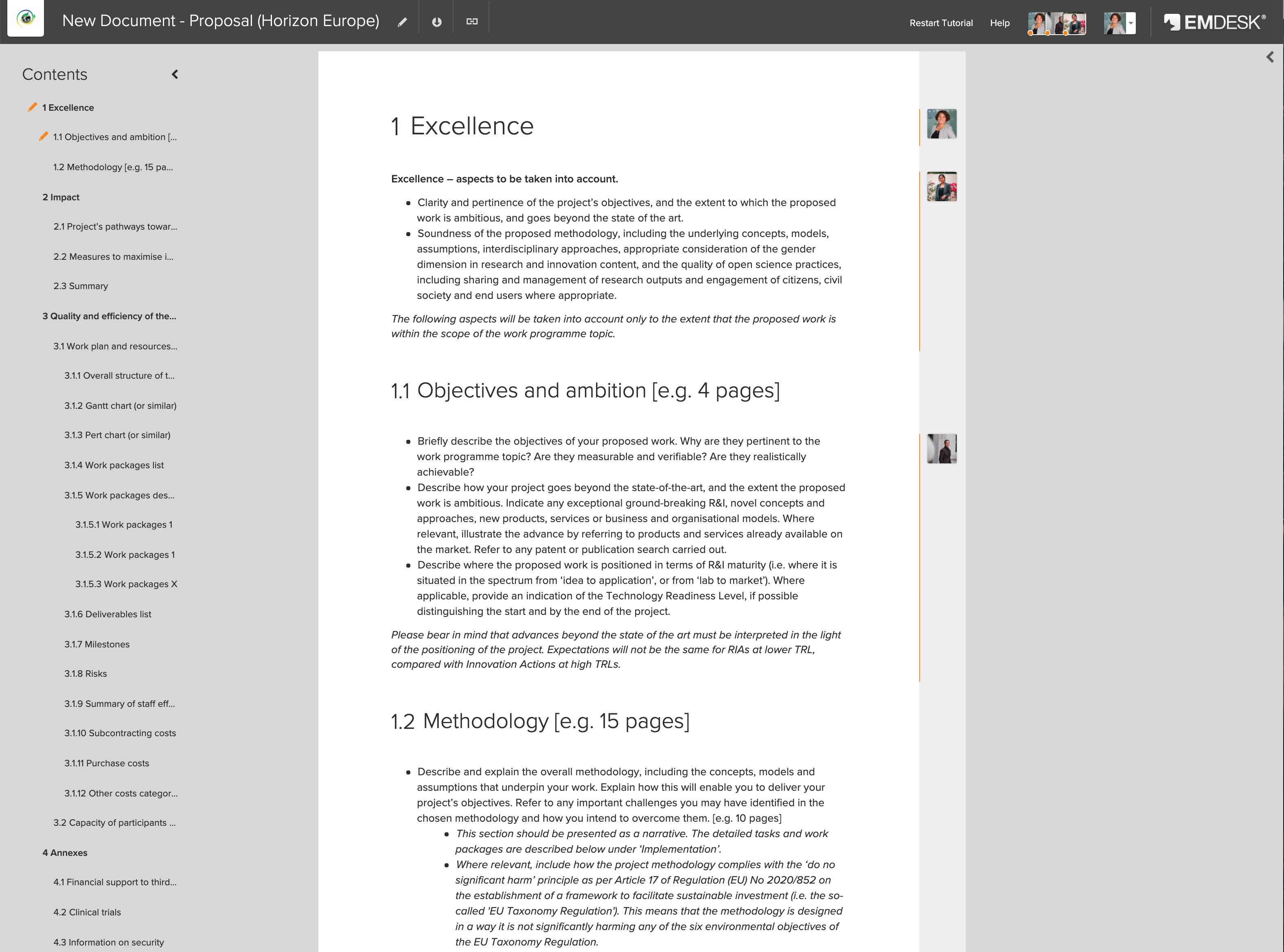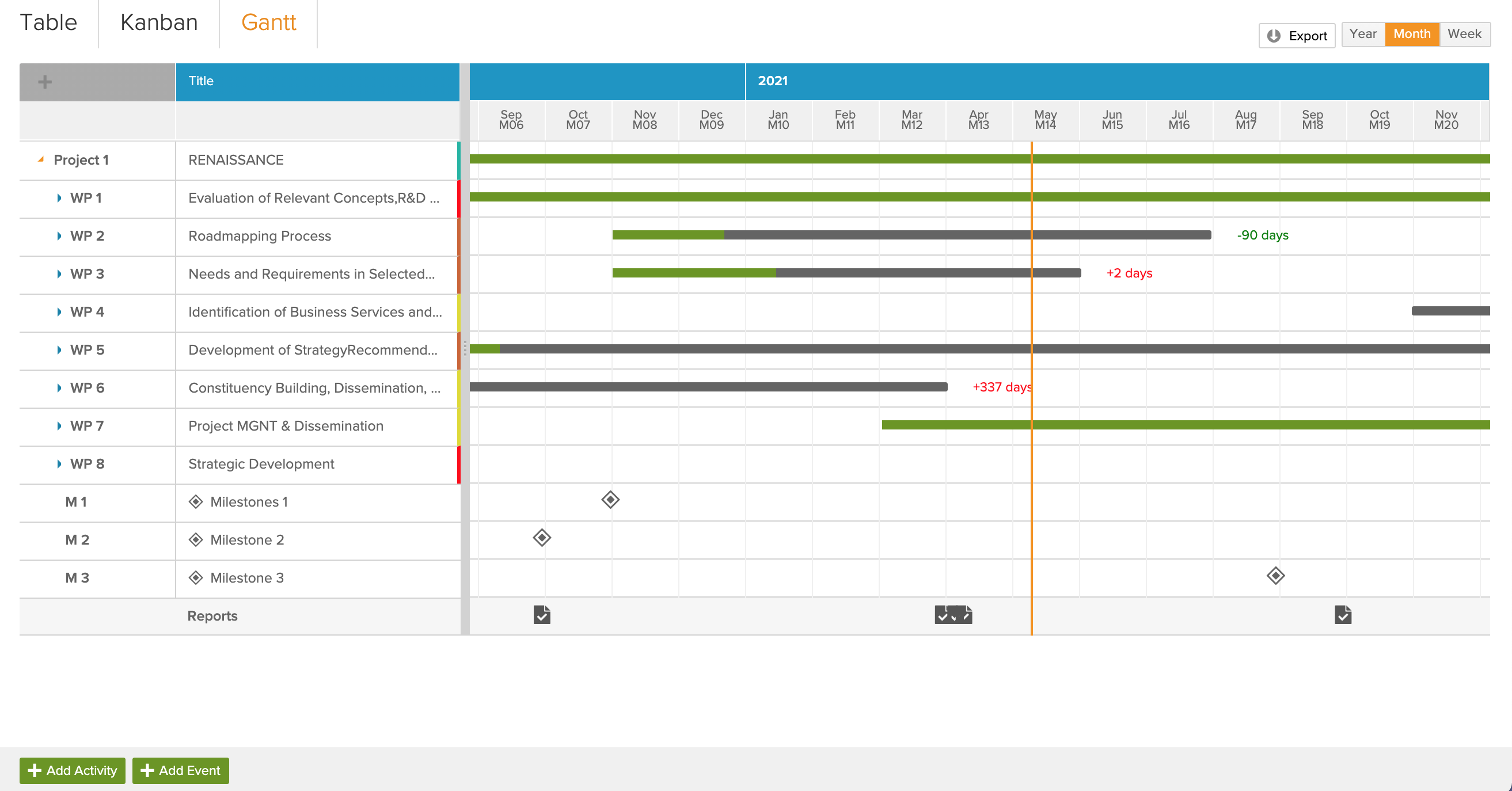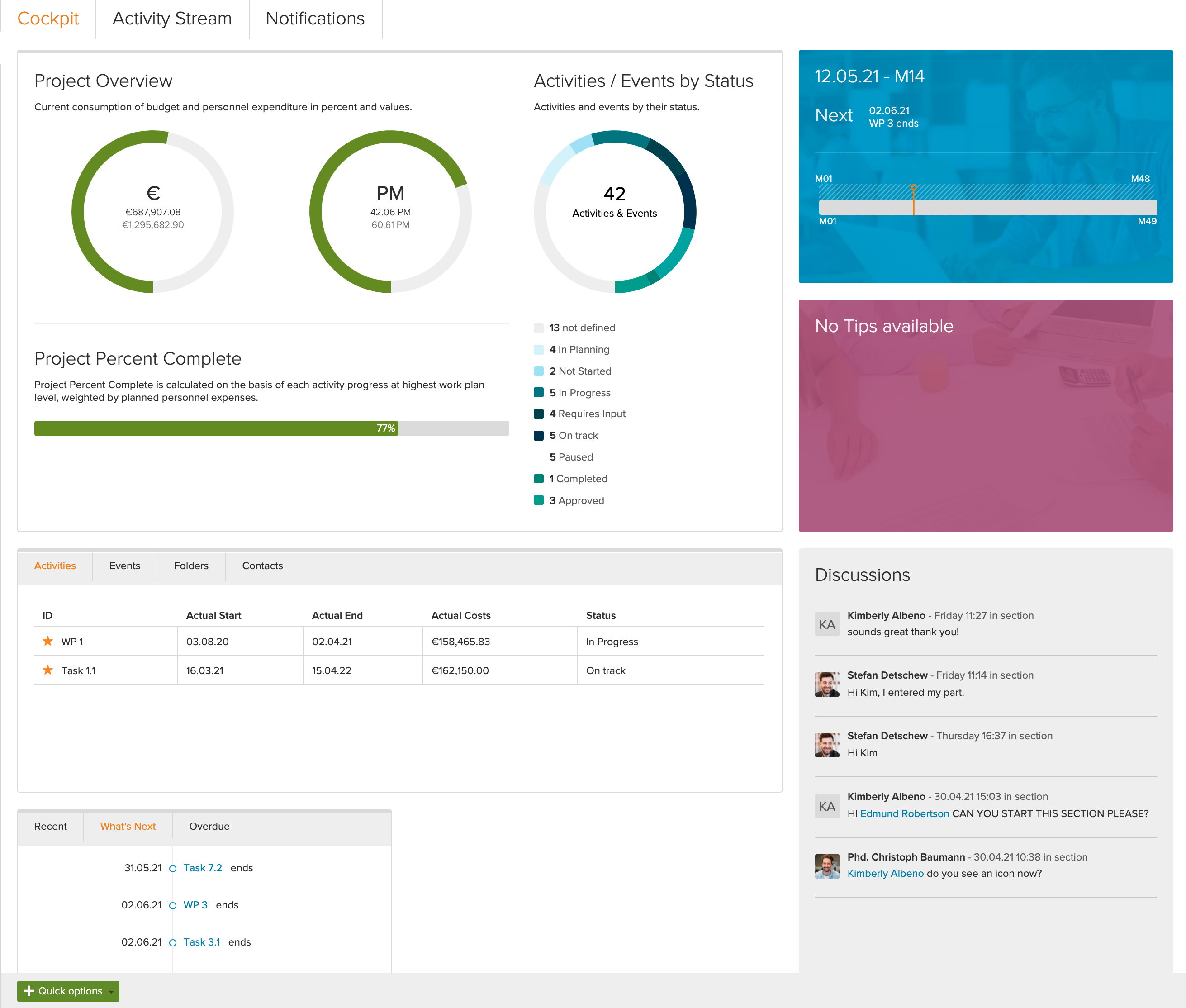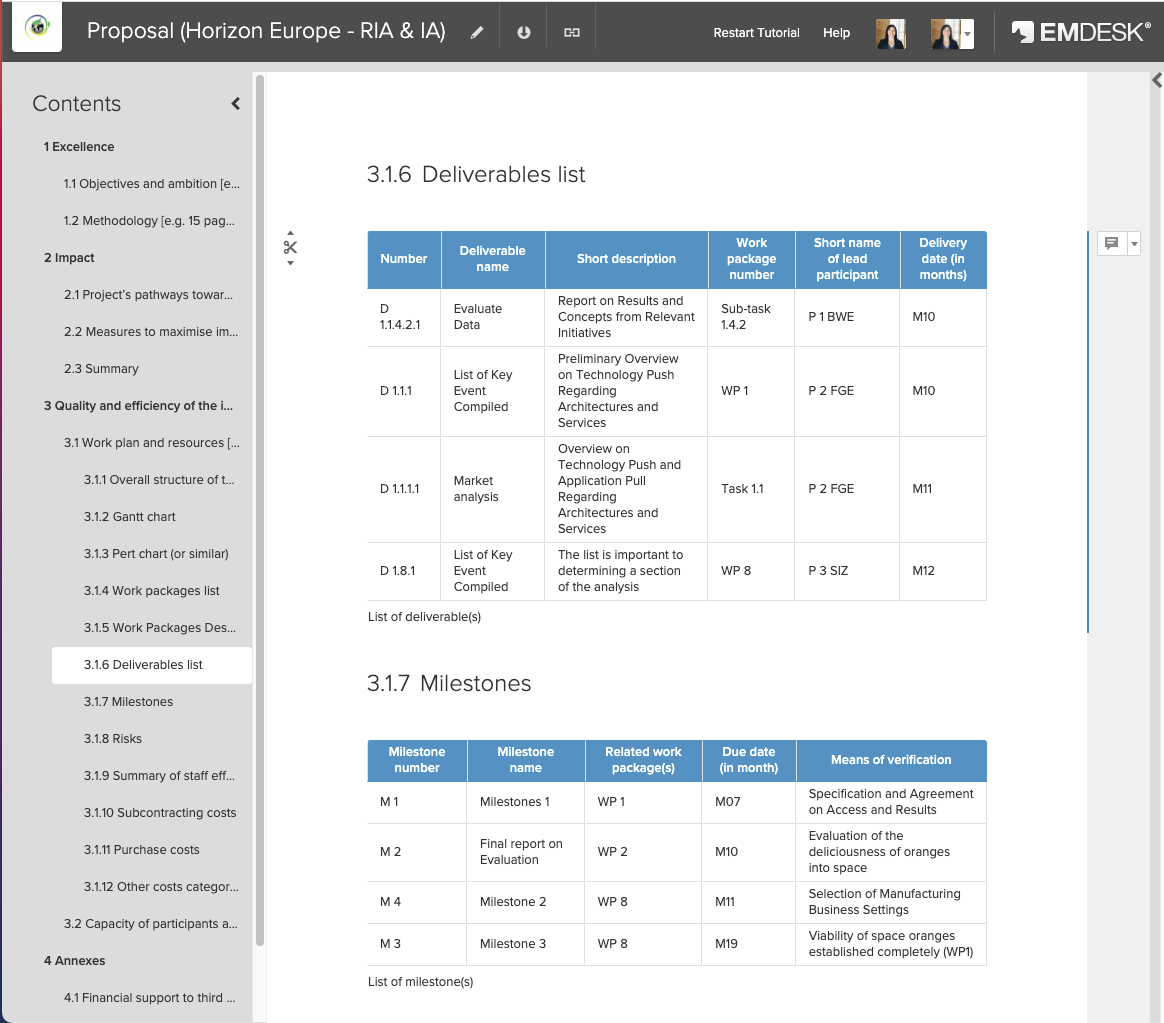The application process for the Horizon Europe Programme requires a great deal of preparation. The large number of requirements for a Horizon Europe proposal can make the development process seem difficult, but EMDESK’s powerful project management tool will help you easily ensure that every requirement is met – freeing up your time and allowing your teams to focus on developing a winning proposal. We’d like to share our best tips and tricks for creating a successful Horizon Europe proposal.
How to apply to the Horizon Europe Programme
Once you have an idea for a specific project, it’s time to start looking for funding opportunities. The first step in this process is to find the relevant funding programme within the Horizon Europe framework. The Horizon Europe programme has a long-term budget of €95.5 billion for 2021-2027. This budget is broken down into programmes that offer funding for the following projects or types of actions:
- Research and Innovation Actions (RIA): Projects that facilitate new knowledge or explore the feasibility of a new or improved technology, product, process, service or solution.
- Innovation Actions (IA): Projects that produce plans and arrangements or designs for new, altered, or improved products, processes or services.
- Coordination and Support Actions (CSA): Projects that contribute to the objectives of Horizon Europe. This excludes R&I activities, with the exception of ‘Widening participation and spreading excellence’.
- Programme Co-fund Actions (CoFund): Projects established or implemented by legal entities managing or funding R&I programmes, other than EU funding bodies.
- Innovation and Market Deployment Actions (IMDA): Projects that include an innovative action and other activities required to bring the innovation to market. (EIC).
- Training and Mobility Actions (TMA): Projects seeking to improve the skills, knowledge, and career prospects of researchers. This is based on mobility between countries and, if relevant, between sectors or disciplines. (MSCA)
- Pre-commercial Procurement Actions/ (PCP): Projects that help a buyers’ group encourage public procurement of research, development and validation of new solutions; and when applicable, the first deployment of new solutions.
- Public Procurement of Innovative Solutions Actions (PPI) Projects that improve the ability of a buyers’ group to have earlier deployment of innovative solutions.
Every Horizon Europe programme and sub-programme has a biannual work programme (WP) with a variety of objectives, topics, calls, and budgets. As such, each call provided in a WP contains all the necessary information you need to be prepared for it. The call is described in detail with the specific challenge, scope, expected impact, and the required type of action.
At present, each of the Horizon Europe programmes has a WP developed for 2021-2022. All WPs are already officially published and can be found on the Funding and Tenders Portal. On the Portal, you’ll also be able to find other documents for the application package, including general requirements and guidances, legislations, templates, budget patterns specific for this or that programme.
What’s the ideal time to start developing a Horizon Europe proposal?
Your Horizon Europe proposal will consist of two large parts:
- Consortium-related activities (recruiting, negotiating, defining functions, managing contributions, etc.)
- Writing-related activities (answering to the call text, objectives, concepts, describing impact, developing work plan and budget, etc.)
Generally speaking, you should start developing your proposal 12 to 8 months before the deadline of the call in order to have everything prepared on time.
Preparing your consortium-related activities
Once you’ve identified a specific topic and call within the Horizon Europe WP, your next steps will be finding partners and consolidating the consortium for your project. Even though some types of action don’t require a consortium, the majority of Horizon Europe grants are collaborative projects. In Horizon Europe there are two eligibility rules regarding the consortium composition. Your consortium should have:
- At least one independent legal entity established in a Member State.
- At least two other independent legal entities. Each entity should be established either in a different Member State or Associated Country.
Note: From 2022 onwards, participants that are public bodies, research organizations or higher education establishments from Member States and Associated countries must have a gender equality plan that cover the minimum process-related requirements:
- Self-declaration will be requested at the proposal stage (for all types of participants)
- The plan must be included in the entity validation process (based on self-declaration).
Preparing your writing-related activities:
Once you’ve solidified your idea and gotten your first partners, you’ll need to register on the Funding and Tenders Portal by creating an EU Login account. The next step is to start writing your application.
We recommend planning at least 2 months for the writing part of your proposal and at least 1 week for proofreading.
Horizon Europe proposals consist of two parts:
- Part A - System-generated, web-based, administrative forms, that contain the information entered by the participants through the submission system in the Funding and Tenders Portal.
- Part B - The narrative portion of the proposal, consisting of three sections that correspond to specific evaluation criteria. Part B will be the largest part of your proposal, and will thus require most time and effort. This document should demonstrate that your idea is ambitious and convince evaluators to fund your project.
Important note: Part B needs to be uploaded as a PDF document following the templates downloaded by the applicants in the submission system for the specific call or topic.
Evaluation criteria – three sections of a Horizon Europe proposal
Part B is where you need to explain the project’s background and goals. A successful Part B demonstrates how these goals will be achieved in the following sections:
1. Excellence
This section clarifies the project’s objectives and their relevance to the project. They need to demonstrate that the proposed work is ambitious and reaches beyond the state-of-the-art. It proves the proposed methodology, including the underlying concepts, models, assumptions are sound.
In addition, it shows that the project will undertake inter-disciplinary approaches, appropriate gender considerations in research and innovation content. It should highlight the quality of open science practices that will be used, including sharing and management of research outputs; and as appropriate the engagement of citizens, civil society, and end users (Excellence only for ERC).
2. Impact
This section focuses on building credibility for the methods and procedures that will be used to achieve the expected outcomes and impacts specified in the work programme. It also demonstrates the high plausibility of the estimated scale and significance of the project’s contributions.
A successful Impact section shows how your project could contribute to the outcomes and impacts described in the work programme (new approach to impact: Horizon Europe Key Impacts Pathways (KIPs)). It’s important to highlight the suitability and quality of the measures used to maximize the expected outcomes and impacts, as detailed in the dissemination and exploitation (D&E) plan; including communication activities.
3. Implementation
This section demonstrates the quality and effectiveness of the work plan and the assessment of the risks. It needs to detail the appropriateness of the overall effort and resources assigned to the work packages. Be sure to highlight the role and capacity of each participant, and describe the extent to which the consortium as a whole can provide the necessary expertise.
Important note: The work proposed in your application must be within the scope of the work programme topic that you’ve chosen. A common proposal writing mistake is to pay too much attention to the Implementation section and describe the work plan in great detail, while not taking enough time for the Excellence and Impact sections. It’s vital that your Part B explains why, in general, your project deserves funding and how it reflects the objectives of the programme you’ve chosen for it.
Evaluators will also be looking to make sure your proposal addresses the aspects of gender dimension and open science, measures to maximize impact (D&E plan), and follows practices that won’t do significant harm to the environment. This is the norm for all Horizon Europe calls, unless it’s explicitly mentioned in the topic description. Specific calls may include or exempt other aspects.
Co-create your Horizon Europe proposal in one place
While you’ll need to develop your Horizon Europe proposal in a timely manner, it’s vital that you pay special attention to and follow the strict requirements of the Horizon Europe proposal. Gain the sense of security knowing that you have everything you need and that you’ve followed all the EC requirements by using a powerful project management tool like EMDESK to support your proposal development process.
Give yourself an advantage by providing your project teams with EMDESK solution that has all necessary communication tools to work together efficiently – an online document editor, a document repository, video conferencing, discussions. It allows you to co-create your project proposal in real-time in one place with all project teams and partners and demonstrate evaluators that your ideas are achievable.



